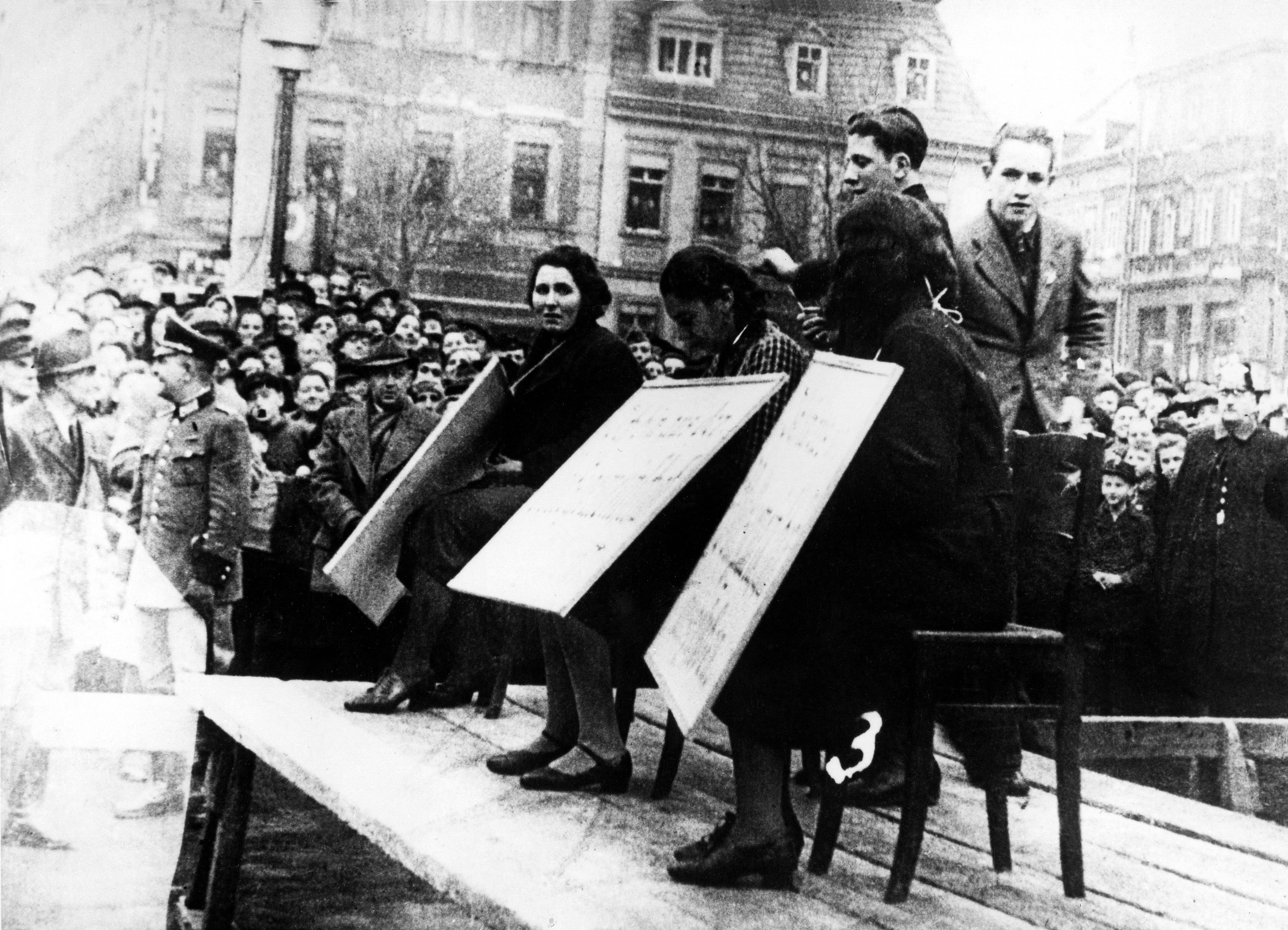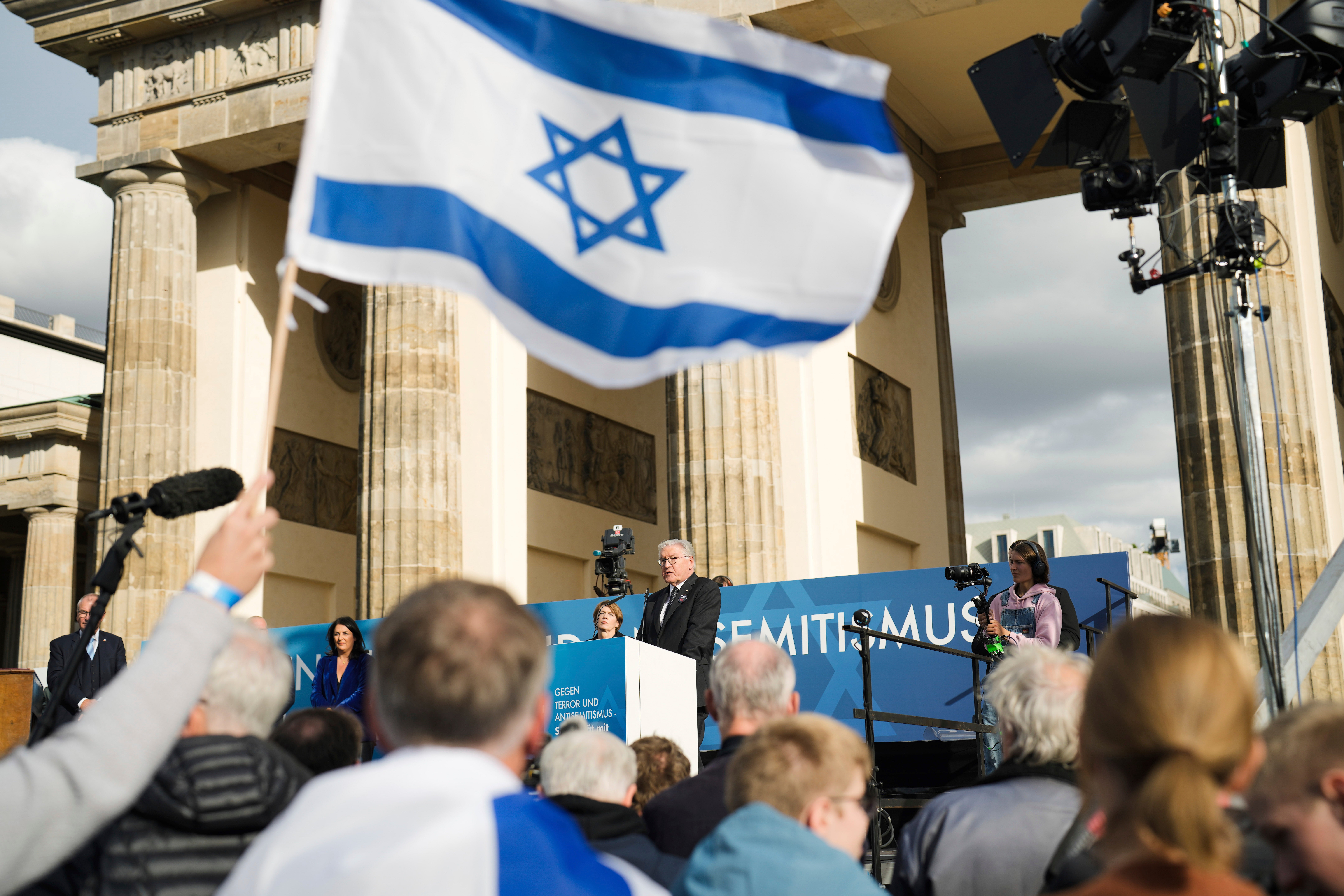My mother survived the Nazis — I’m happy she can’t see Germany today
Comparisons with the 1930s are lazy, says John Kampfner. But on the anniversary of the brutal Nazi pogrom Kristallnacht, and in the shadow of the ongoing Israel-Gaza war, he travels to Berlin to talk to a Holocaust survivor’s son who is shocked by the rising tide of violent antisemitism in Germany and across Europe

I am so happy that my mother is not around to see this now.” Hermann Simon and I were talking on the eve of the 85th anniversary of Kristallnacht, the pogroms of November 1938 across Germany that presaged the Holocaust. We were talking also exactly a month since Hamas carried out its massacre of 1,400 Israelis on 7 October – the largest single day of murder of Jews since the defeat of the Third Reich.
Simon’s words were not mere musings. His mother survived the war by hiding underground, one of a tiny number of Jews who submerged, literally, to stay alive. Her son says that for the first days after last month’s terrorist attack he too had the urge to hide, deciding not to go to his local synagogue on that first Friday.
Simon is one of the most exceptional figures in contemporary Berlin Jewry, his life exemplifying the terrible history of Jews in Berlin – and a certain redemption that followed. But first his mother: an orphan at the age of 19, in 1941 Marie Jalowicz Simon was sent into forced labour at a Siemens factory, going from home to home, all the time hiding, famished, often exploited, and living in unsanitary conditions. She avoided almost certain death when, in June 1942, dressed only in her petticoat and pretending to be a neighbour, she slipped past the two SS men who had been sent to pick her up. On the rare occasions she needed to venture onto the street, she would not wear the yellow star required of Jews. For a time, she stayed in a villa outside the city with a circus performer before being “sold” for 15 reichsmarks (around £70 in today’s money) to a syphilitic, ardent Nazi.

After the war, she followed the strictures of the young East German state, which exhorted its people to focus not on the legacy but on constructing a new society. Having been wary of talking about her experiences throughout her adult life, and with the GDR long gone, she agreed to tell all to her son just before her death in 1998. In nine months of conversations, his tape recorder perched on a table in his parents’ apartment, Simon produced 77 tapes of her recollections and 900 pages of transcribed notes.
Untergetaucht – translated into English as “gone to ground” – is the story of the 1,700 Jews who became U-boats, submarines. She describes all manner of horrors, culminating in her rape by a Soviet soldier. But she also tells her son, 40 years later: “I have emigrated from Hitler’s Germany to the Germany of Goethe and Johann Sebastian Bach, and I feel very comfortable there.”
Would she now, amid a renewed spate of attacks and threats, in Germany and across Europe?

The German government’s commissioner on antisemitism, Felix Klein, said this week that “hatred of Jews has reached a level not seen for decades”. He was speaking at the launch of a report by an organisation called the Amadeu Antonio Foundation, named after a young Angolan contract worker clubbed to death by thugs days before reunification in 1990. “Antisemitism has taken a foothold again in Germany, and that means the room for Jews has shrunk,” the report states.
The most visible acts of intimidation came in the first few days after 7 October – a synagogue in Berlin hit by molotov cocktails, several houses daubed with the Star of David, and other violence. Security has been considerably reinforced around Jewish institutions but Simon says the fears are more inchoate, and potentially longer lasting. “They can make buildings safe but they can’t ensure your safety every step of the way getting there.”
In amongst the fear has come copious amounts of reassurance. Simon speaks of neighbours and acquaintances, not just close friends, who have written notes to express solidarity and offering support. He, like many Germans, was grateful for an address made last week by Robert Habeck, Germany’s vice-chancellor.

One of the leading Greens and also economics minister, Habeck issued a video online calling out some Muslim groups for failing to condemn the original attacks and criticising protesters on the left for allowing “anticolonialism” to turn into antisemitism. “The responsibility of our history also asserts that Jews can live freely and safely in Germany. That they never again have to fear to show their religion, their culture openly. But precisely this fear is now back,” he said.
Habeck’s intervention was all the most noticeable because it outshone the chancellor, Olaf Scholz, and the president, Frank-Walter Steinmeier. They too had denounced the attacks and given full support to Israel in the immediate aftermath, but somehow their statements had failed to resonate.
Across the political spectrum, from the three parties that form the ruling coalition, to the opposition Christian Democrats, even to the far-right Alternative for Germany – for more cynical reasons; they are more hostile to Muslims, there has been a broad consensus to the crisis. Scholz has refused to call for a ceasefire, putting him in the camp of the US, UK and others. He was the first European leader to visit Israel, declaring it had “every right to defend itself”.
Germany’s emotional proximity to Israel began within a few years of its surrender in 1945, with Germany’s chancellor Konrad Adenauer and Israel’s first prime minister David Ben-Gurion establishing a close bond. Perhaps the most evocative moment in the intervening years was a speech by Angela Merkel before the Knesset in March 2008, marking the 60th anniversary of the founding of the state of Israel. She declared that support for Israel was an integral part of the staatsraison, raison d’etre, of the Federal Republic; all Germans would bow their heads in shame in perpetuity in memory of the Shoah, she said.
Yet for some, statements such as that denote more rhetoric than action. Ruth Ur, a leading cultural figure who is now director of the German Friends of Yad Vashem, suggests the problem lies less with politicians, more with civil society, particularly the cultural community. “I see a double standard and a shocking lack of empathy,” she tells me, on her way back from the Brandenburg Gate where she had attended a one-month-on vigil marking 7 October.

Artists, she says, are ever eager to attack Israel for the plight of the Palestinians but are far more reluctant to rally to its defence. Her experience is not dissimilar to that of Simon, or other Jews in Berlin. She has temporarily moved out of her office and is more careful about where she goes, but she has also been touched by the support she has received from individuals.
In a country that never takes its politics lightly, that wears its history heavily on its shoulders, the Israel-Gaza crisis dominates not just the headlines in Germany but many conversations – just as Russia’s invasion of Ukraine did until eclipsed by the Middle East.
Everywhere you go in Berlin, you are confronted by the past, whether it be the Memorial to the Murdered Jews of Europe in the heart of the city, or the Topography of Terror close by, the empty underground library on the square where the Nazis burnt Jewish books, Platform 17 at Grunewald station where Jews were transported to their death, Sachsenhausen concentration camp merely an hour away to the north – or the “stumbling stones” outside many a building listing denoting the name of an inhabitant and where they were exterminated.
The city and the country’s rediscovery of its Jewish heritage is not confined to monuments. Berlin has developed a modern Jewish outlook, doing all it can to attract Jews whose forebears had been murdered or forced to leave – and those who had not known the city. The process is often fraught, but it is also sincere and optimistic. For several years, it had been the destination of choice for thousands of young Israelis, many aspiring artists or musicians, wanting not so much an intense reconciliation, more a fun city in which to hang out. Israeli restaurants were all the rage. Will that faith survive this moment?

For all their fears, Ur, Simon and other members of the community note two important pieces of context. The incidents of violence are not specific to Germany. They have taken place in several European cities, which doesn’t make them any more palatable, but worth noting. As are the incredibly impassioned discussions about when it is right, and wrong, to criticise Israel and/or to support Palestinians. The police in Germany have clamped down on pro-Palestinian rallies with special vigour.
Comparisons with the 1930s are lazy. Yet this period will be important for the country, in its foreign-policy role, and in its dealing with hate crimes and in the still-unfinished business of ensuring a safe and respected role for Jews in the heart of society.
Simon has curated several exhibitions on Jewish life and the remembrance of victims, a career for which he has received many decorations. In 1988, shortly before the Wall came down, he became director of the newly founded Centrum Judaicum foundation, whose main task was to bring the New Synagogue back to life. That finally happened in 1995. Its inauguration was attended by the chancellor, Helmut Kohl, and dignitaries from all walks of life. It was a mirror of its original consecration in 1866, with Bismarck as guest of honour. Invitations to both occasions were the hottest tickets in town.
John Kampfner’s new book, ‘In Search of Berlin, The Story of a Reinvented City’, is published by Atlantic






Join our commenting forum
Join thought-provoking conversations, follow other Independent readers and see their replies
Comments